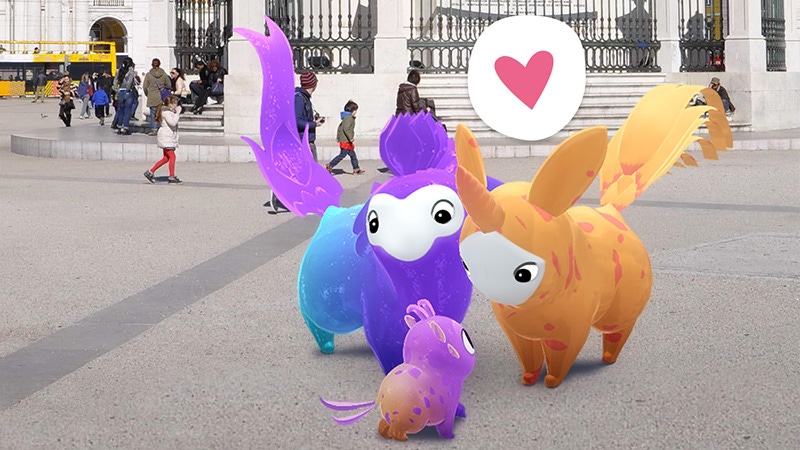Niantic's new AR-first game Peridot shows off impressive tech, but can it buck the conventions of free-to-play game design?

In the years since the blockbuster launch of Pokémon Go, Niantic's follow-up titles have mostly been riffs on that game's formula (which itself was an evolution of Ingress, so maybe the design logic starts there). When you thought about Niantic, you thought about playing games laid over real-life geography.
Its new game Peridot, which landed this week, is the first game to significantly buck that trend. Though it employs augmented reality in a similar fashion to Pokémon Go, it's the first example of how Niantic's AR-oriented development on projects like Lightship AR platform and Campfire can combine into one product.
Gone are the digital streets filled with checkpoints and virtual creatures. What's replaced it is a game meant to keep your phone's camera on while you're playing it, so you can interact with your Peridot in a familiar environment.
If Peridot takes off, it'll be a big win for Niantic, which has struggled with layoffs and canceled projects in its attempts to build the next successful game post-Pokémon Go.
Can the studio pull that off? At first, I thought the question hinged on if Peridot players will truly want to connect with their digital creatures. But more importantly, can that connection happen if players are stuck on the treadmill of free-to-play game design?
What makes Peridot different from other Niantic games?
As mentioned, Peridot is the first game from Niantic that isn't anchored in keeping your phone on while walking around real-world streets. There are some geolocation mechanics, but the main name of the game is playing with a ridiculously cute creature through your phone's camera lens.
Said creatures can be collected and bred with each other to create new unique variations. There's a fairly impressive "DNA" system in Peridot's software that enables up to 2.3 x 10^4 variations, meaning there's a pretty good chance that every single Peridot that players acquire will be perfectly unique.
If you're the kind of reader who remembers Chikai Ohazama as Niantic's director of web3, you might be wondering if there's any blockchain technology involved in all this. "Nope," says Niantic director of production Ziah Fogel. "Right now we're focused on refining the core gameplay experience to ensure that it's fun and accessible. We're using non-blockchain technology to make sure that we store all the creature information—and unique DNA—on the game side."
Once players hatch their Peridot, they're able to play fetch with it, pat its head, teach it tricks, tell it to forage for food, and give it belly rubs. There's a quest system in place to drive player engagement and fill them with tasks, described as "desires" (and also straightforward weekly quests). Desires task players with showing their Peridot different objects, playing with it, feeding it specific foods, etc.
Pokémon Go's long walks through your neighborhood or a downtown area aren't as incentivized under this system. Though there may be some desires like "go for a short walk," there's a lot more gameplay in sitting down and staring at your Peridot—and of course, taking cute photos with it.
The most impressive new features not seen in other Niantic games are the improvements in AR interactivity. Player Peridots are able to identify different types of terrain (which offer different rewards when foraging), can distinguish a person from an animal, or even recognize your television set (though for reasons I don't understand, showing your Peridot your TV will apparently prompt it to "nudge you to go play outside.")
It's not a perfect technology. When my Peridot (named "Frambis") asked me to show it a cat or dog, I brought it upstairs to meet my Mom's grumpy, ready-to-kill-you cat. It seemed to not be able to identify the cat, possibly because of the lighting in the room.
Later, when it asked me again to show it a cat or dog, I pointed the phone at some nearby pigeons. Frambis was satisfied.

Frambis IS really cute, I'll give him that.
There are some motivating reasons to explore the world with your Peridot. Once it's grown into an adult, you can pop by different geographic waypoints and "Display" it for other Dot trainers to discover. If that Peridot has traits you'd like to include in your stable, you can connect with the owner on Niantic's social network Campfire to discuss breeding.
If you have your phone open while heading out and about, your Peridot will trot alongside you—which is cute, but only works if your phone is on and burning through battery with the camera online. (To say nothing of needing to stare at your phone while walking on a sidewalk or dodging traffic in a parking lot).
When you're not on your phone, your Peridot might swing by waypoints you visit and grab some needed supplies. Passive activity like this helps counter some of the limitations that come from trying to take your Peridot on a walk. And it was the passive activities I really enjoyed the most—seeing my Peridot behave "on its own" as a consequence of my travel was in some ways more engaging than pointing my camera at ducks.
Because while you do have the game—it highlights how exhausting free-to-play retention mechanics have become.
Peridot shows the limits of free-to-play design
A decade ago, a game with Peridot's technology would have made me excited about the mobile game market. It's a very neat creature breeding simulator with good foundations for improvable AR technology, the kind of game that can only exist on smartphones.
And then there's just...the reality of the modern App Store market. To build a sustainable model that will attract players, you have to engage aggressively and then monetize like hell.
Spend even a little bit of time with Peridot, and you can feel it trying to get you on the treadmill that sooner or later leads to spending. That treadmill is fueled through a usual amount of FOMO (fear of missing out) driven by daily quests, but maybe more frustratingly, by playing on players' natural empathy to protect and care for these cute creatures.
To breed Peridot in a bid to participate in the "trait" system, players need to spend money. To unlock certain cosmetic items, players need to spend money. And if players want to quickly acquire food or objects needed for certain quests/desires...players need to spend money.
In-app currency is earnable through gameplay, but obviously, that takes time. You can speed up that path just by buying it through the store.
Though Peridots can't die like virtual pets from generations past, (Fogel was very emphatic about this), there's just something that tugs at the heartstrings when you log in and see this big-eyed bugger wants some food. That's not to say Niantic will immediately try to charge you real money for said food, it's just the kind of instinct that will make you hop on the aforementioned treadmill of play.
I wouldn't go so far as to call that exploitative, but it's at least uncomfortable. In Pokémon Go, I wasn't worried about if my creatures would go hungry while I wasn't logged in. But I could feel that itch scratching at me whenever a push notification hit my phone.
It's unpleasant. When live service games gate progress behind time or money, plenty of players will build schedules around investing the needed time. And when you structure your schedule like that, games begin to feel like work.
If Niantic really hopes to break new ground in the world of AR-driven gameplay, I hope it also eventually improve the mobile game systems that drive Peridot's retention. Because for now, all innovations in the AR world feel shackled by the restraints of the very marketplace it's sold on.
Read more about:
FeaturesAbout the Author(s)
You May Also Like









